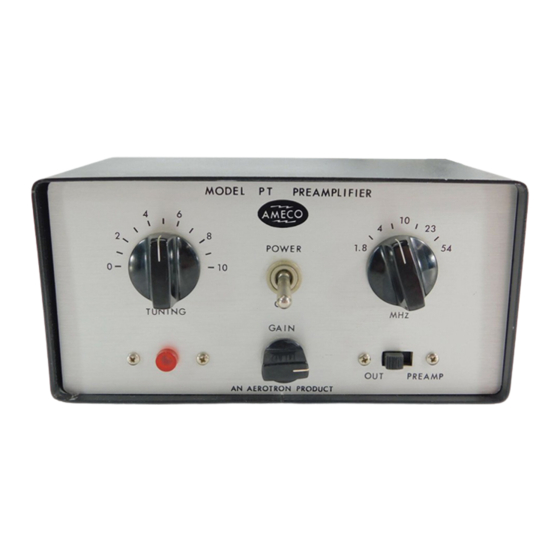Ameco PT Petunjuk Manual - Halaman 3
Jelajahi secara online atau unduh pdf Petunjuk Manual untuk Penguat Ameco PT. Ameco PT 9 halaman. Preamp tube type

5.
6.
7.
8.
INSTALLATION OF
A
SECOND
RECETVER
To connect
a
second
receiver, it is
necessary
to
run
a coaxial
line
from the
AUX
RCVR
auto radio-type
jack,
on
the
rear
of
the
PT,
to the
receiver.
An
auto
audio-
type plug
is
supplied
with
the
PT, and
a coaxial
cable
of the
RG58/U
type
should
be
i
nstal
led as fol
lows:
l.
Remove
outer
vinyl
covering
for
1-7/8
inches.
2, Strip
braid
and
inner insulation
off
center
conductor
7
/8
i
nch.
3.
Push
braid
back
to
form
a
bead
all
around.
4. lnsert
center
conductor through
pin ufitil braid
is
aga
i
nst
end
of
pl ug.
Bend
center
conductor
to
hold plug
in
place.
Roll braid
between
fingers to roll it
over the
end
of
the plug
for
about
l/15
inch.
Solder
the braid
to
the
four
tabs
of
the
plug.
Solder the center conductor
to
the
pin
and
cut
off
excess
wi
re.
After installation of
the
above,
the
PT
will
feed
the
second
receiver as
well
as
the
transceiver. This
will
make
it
possible
to
receive and transmit on separate frequen-
cies
when
using
the
PT
or to
scout
the
band
without disturbing the
setting of
the
tuning
dial of
the transceiver.
lt
also
will
be
possible
to
use general
coverage
receivers
without
having
to
disconnect the
antenna
from
the transceiver installation
and by
means
of
the proper
frequency
selection
of
the
PT,
all
band
reception
may
be
had.
The
rear
of
the
PT
contains three terminals
(designated
AUX CONTACTS)
for
muting
the
second
receiver. This
is
highly desirable
when
transmitting
so
that
noise
and slgnals
do
not ride
through
on the transmitter audio.
Under
certain conditions,
feedback
also might develop,
particularly with certain relative
frequency
settings
between the
transceiver
and
the
second
receiver.
Before connecting
the muting terminals,
it will
be necessary
to
determine from
the receiver lnstruction
Manual
if
normally-open or
normally-closed contacts
are
required
for
muting.
ln
those
receivers,
muting against
ground,
the terminal
marked
COM
should be connected
to
ground
or
chassis
of
the
re-
ceiver. ln
those receivers
requiring
normally-closed contacts
for
reception,
the
terminal
marked
NC
should be connected
to
the muting Iead.
Those
receivers requiring
normally-open contacts
for
reception,
will
require
that the
leads
be connected to
COM
and N0
terminals.
Most
receivers,
however, use
normally-closed contacts
for
re-
ceiving,
which
open
during transmit.
After wiring in
the
muting
contacts
to
the
second
receiver,
each
time the transceiver transmitter section
is
actuated,
the
second
receiver
should si lence.
lf it is
desirable
to
use
VOX
operation
with the
second
receiver, it is
necessary to
observe
certain
precautions so
that
the output
of this
second
receiver
will
not
trip
the
VOX
circuitry.
Although
it is
possible
to
modify
the transceiver,
so
as
to
feed
audio from
the
second
receiver
in for anti-trip
purposes,
this is
not
normally rec-
ommended
unless the person performing
the task
has
a very
thorough
knowledge
of
the
circuitry
and can perform these
operations. For
split
frequency
operation,
it
usually
is
best
to
use
a footswitch
or
other
such
control circuitry with the transceiver
in
the
V6X,
PTT
or
manual
modes
of
operation.
lf,
however,
VOX
is
desired,
it is
best
to
experiment
with
the
placement
of
the
microphone
with
respect
to
the
speaker
of
the
second
receiver,
so
as
to
attenuate the audio path
between
the
two as
much
as possi-
ble.
Keeping
the
second
receiver
volume
at
a
modest-to-low
level
also
will
be very
helpful
and
the
use
of
a cardioid-type
microphone
will further
improve
the situation.
